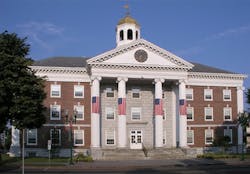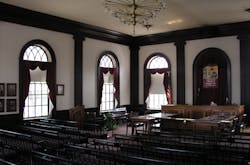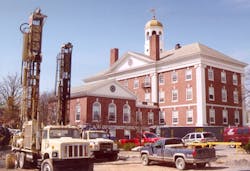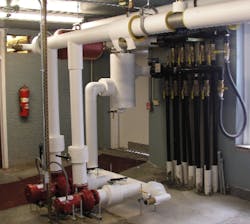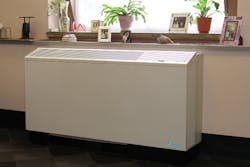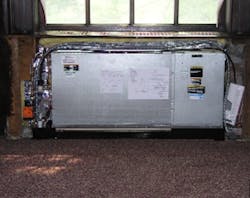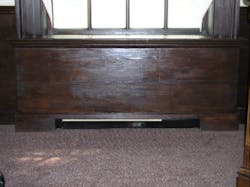Historic City Hall’s Character Preserved With WSHP Geoexchange System
Featuring a masonry exterior over a steel frame, a columned porch, pediments, pilasters, and other fine details on the outside and high ceilings, stenciling, wood paneling, marble accents, and an ornate city-council chamber modeled on an old Boston courtroom on the inside, Memorial City Hall in Auburn, N.Y., projects a stateliness city officials wanted to preserve. The heating and cooling system, however, was another story. The building, listed on the National Register of Historic Places, featured a wheezy steam boiler and no air conditioning—just gusty window and ceiling fans that seemingly blew only hot air (and papers), causing employees to swelter through hot summers, with temperatures topping 95°F in some offices.
A gas boiler and central air system would have been a conventional choice, but design engineer John Manning, PE, of Earth Sensitive Solutions LLC recommended the city consider an alternative that might even exceed expectations: a geoexchange heating and cooling system. Designed by Beardsley Design Associates Architecture, Engineering & Landscape Architecture, the system is compatible with the building’s historic character. As a result of design studies and careful retrofit, water-source heat pumps (WSHPs) from Daikin—now installed in city offices, meeting rooms, and hallways—deliver comfortable conditioned air while preserving and even enhancing the building’s architectural integrity.
Memorial City Hall’s new heating and cooling system had to meet several criteria: It had to be cost-effective, be energy-efficient, provide a more comfortable working environment, and blend into the landmark building both inside and out.
The Geoexchange Alternative
Geoexchange systems use the earth, which absorbs and stores up to 47 percent of the sun’s energy, according to the U.S. Environmental Protection Agency, as an energy source.
During winter, water is pumped through underground pipes into the building, where the heat pumps pull heat from the water and distribute warm air to individual rooms or zones, such as corridors or groups of offices. During summer, the process is reversed, with heated water transferred out of the building into the underground pipes, where it is cooled by the earth. During transitional seasons, some parts of the building may require heating, while others require cooling.
Geoexchange systems include three main components:
- An earth connection, such as polyethylene piping, for transferring heat between water and the earth.
- One or two circulating pumps for moving water into and out of the building.
- WSHPs in each zone for delivering required heating and cooling.
Research Seals the Deal
Manning and Mike Long, grants manager for capital-improvement projects for the city, developed a feasibility study comparing conventional heating systems with geothermal technology. The study considered:
- Installed costs: For initial installation, estimated capital costs were about the same for the two systems: just under $1 million. The geothermal system cost slightly more.
- Operation and maintenance costs: Annual heating and cooling costs for the geoexchange system were significantly less, with total annual savings estimated at over $19,000.
“These savings and the competitive initial cost contradict a common misperception that geoexchange systems are far more expensive than conventional systems and will take a long time to pay back,” Manning said. “Another misperception is that geoexchange systems can be installed only in a few geographic areas.”
- Emissions: The geoexchange system was determined to generate 58 percent less carbon-dioxide emissions.
- Aesthetics: The city did not want a system that would detract from the visual appeal or compromise the historic integrity of Memorial City Hall. Here again, the geoexchange system came out ahead. Unlike a chiller, it has no visible external components and generates no external noise.
Impressed with these advantages, the city approved a million-dollar bond issue to cover the cost of the project.
Installation
A critical factor in the performance and cost-effectiveness of a geoexchange system is the number and the depth of the pipes in the loop field.
Engineering tests called for a series of 35 6-in.-diameter holes bored 400 ft below the parking lot behind Memorial City Hall. Each pipe was connected at the bottom using a “U” bend fitting so water could be sent down one pipe, cooled or heated by the constant 54°F temperature in the ground, and come up another pipe. Additionally, a series of horizontal pipes was laid several feet under the surface to connect the vertical pipes. The horizontal pipes run to a valve manifold in the basement of the building. From there, small pipes carry the heated or cooled water to multiple Daikin WSHPs in offices and other areas of the building.
Blending the Old With the New
During installation, contractors were able to take advantage of the building’s features to “hide” the geothermal system. For example, the original radiators on the first floor were covered with ornate grillwork. After the radiators were removed, the covers were re-used to house the heat pumps.
The installation was a study in how to minimize disruption to original architecture. On the second and third floors, engineers considered where to put the pipes that would carry heated or cooled water to 72 heat pumps installed in offices. Running pipes along the ceiling would have required cutting through some of the steel beams. Engineers elected to run the vertical pipes alongside the beams, enclosing them and the beams in drywall. Horizontal pipes were run along the floor and enclosed in 6-in.-by-22-in. knee walls. The walls were capped with Corian material that looks very much like the marble windowsills above. It is hard to tell the knee walls have not been there all along.
A Phased Implementation
The heat pumps control the environment in specific zones, independent of other areas. So, one of the advantages of geoexchange systems is that they can be brought online in phases. The installation team started at the top—the hottest area—and worked its way down. Floors became operational every two weeks.
Implementation of a full control system completed the installation. The control system gives occupants more flexibility in terms of temperature control than other cooling systems would. The set temperature of the control system is 68°F; Memorial City Hall employees can vary this by ±3°F.
“The Daikin units distributed throughout the building give us an economical system with the added advantage of individual controls,” City Manager John Salomone said. “Our employees like that kind of flexibility.”
Results
Memorial City Hall now has a working environment to match its visual appeal and historic character. Not surprisingly, the reaction among employees has been overwhelmingly positive. And there is a side benefit.
“We’re on a busy highway,” Salomone said. “In the summer, the offices are much quieter now.”
For Design Solutions author guidelines, call Scott Arnold, executive editor, at 216-931-9980, or write to him at [email protected].

